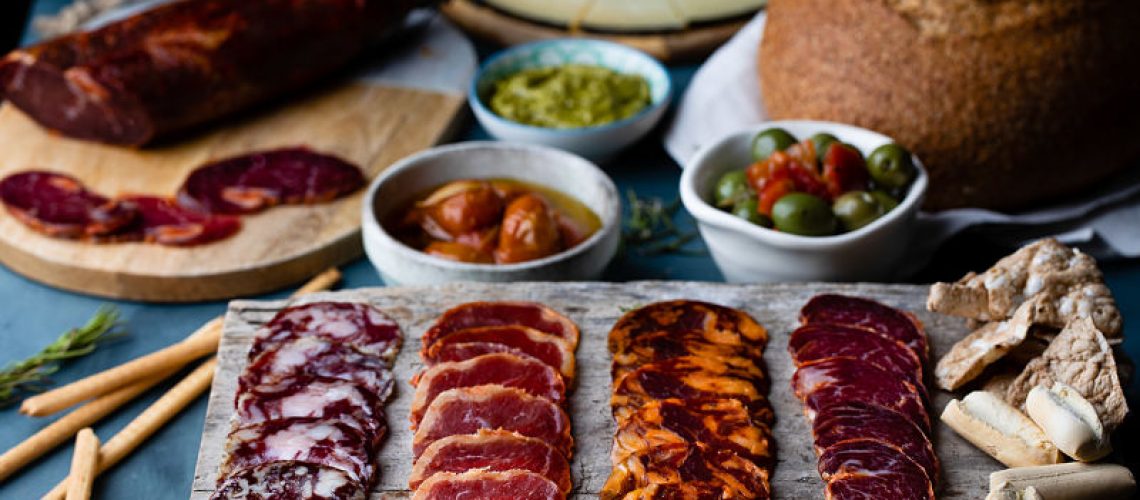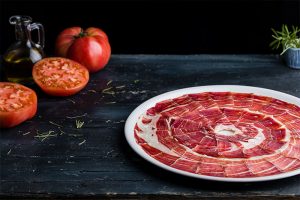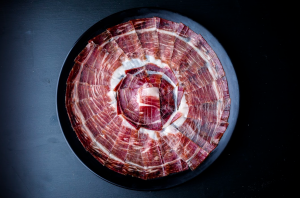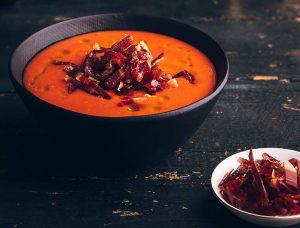You’re a die-hard jamón ibérico fan: you love a delicate slice of nutty acorn-fed ham with its unique Iberian characteristics that melt magnificently into your mouth. There truly is nothing like it. But perhaps you’re looking for a new addition to your spread of cured meats, or something to accompany the cured jamón (ham) or the paleta (shoulder) you’re proudly displaying in your kitchen. Luckily there is so much to discover when it comes to Spain’s cured meat culture.
Make the journey to Spain and you’ll find locals enjoying plates filled with a wide variety of local charcuterie: slivers of luscious caña de lomo, brilliant slices of smoky chorizo, pieces of peppery salchichón, and dark morcilla sausage. They, along with the great jamón, all play a crucial role in building an authentic Iberian meat board. And why wouldn’t they? With some of the best raw materials in the world— Iberian pigs grazing freely on acorns and natural grasses—it only makes sense to develop creative ways to utilize every part of the animal.
Here, we discuss some of the best Spanish cured meat varieties, each with their own delightful and unforgettable nuances. This is a nose-to-tail tradition at its finest.
Caña de Lomo
Caña de lomo, or cured pork tenderloin, is one of the most luxurious styles of Spanish cured meat, right after jamón and paleta. Outside of Spain, it’s not as well-known, but it’s one of the country’s hidden culinary secrets that can’t afford to be overlooked.
The caña de lomo is made from a select, premium-quality piece of lean pork meat and is cured whole in the traditional form, for a minimum of 70 days. What’s especially unique about caña de lomo is that it’s cured in more than just salt: each piece of loin is rubbed with an intense Spanish paprika and garlic, which permeates the meat throughout the curing process. This produces a smoky aroma and incredible flavor in every bite.
Slice a piece of caña de lomo and you’ll notice the balanced waves of fat running through the tender meat. This perfect marbling gives it a soft and malleable texture that practically dissolves in your mouth.
Salchichón
Salchichón could be described as a Spanish-style salami at first glance, but it is so much more. This luxurious cured Spanish delicacy can be made using a variety of meats and beautiful fats, from pork to beef to wild boar. Spices of all sorts are often added into the mix to complement the flavors of each style of meat.
At COVAP, we start with the right ingredients and make our salchichón from that same high-quality 100% Iberian pork that’s raised on grasses and acorns. This is what gives it that unique, Spanish flavor you can’t find anywhere else in the world.
Our salchichón is naturally dry-cured in salt in the traditionalSpanish method. We also use black peppercorns to season the meat, giving it a pleasant spicy note that complements the nuttiness and silky fat from the Iberian pork. A thin slice of salchichón delivers tons of Spanish flavor.
Chorizo
You may have tried different versions of chorizo in the U.S., but cured Spanish chorizo is something entirely different. Chorizo is one of the most celebrated Spanish-style meats, and there are so many different styles and uses for chorizo in the country. Some chorizos are spicy, others more smoky or evensweet. Some are traditionally used in stews in the winter, while others are dry-cured and sliced thin. It’s an easy way to add loads of flavor to the simplest of dishes, from potatoes to eggs to a simple piece of bread.
Just like the rest of our products, our chorizo at COVAP is made with acorn-fed 100% Iberian pork. This exceptional meat is mixed and marinated with loads of high-quality smoky Spanish paprika, a touch of garlic, and cured in salt for over 70 days.
The traditional preservation method of dry-curing in salt results in a soft and tender texture, where the fats meld perfectly into the meat. And of course, that paprika gives the chorizo it’s bright red hue and that quintessential smoky flavor that sets Spanish chorizo apart from the rest.
Morcilla
Morcilla Ibérica showcases the many characteristics of an Iberian pig and offers a unique and delightful flavor to any Spanish charcuterie board. You’ll find all sorts of varieties of morcilla, or blood sausage, throughout Spain. It’s a traditional way of making sausage that’s been used for centuries, taking advantage of every part of the animal.
Artisans mix Iberian pork meat and blood with other ingredients like spices and onions, while others may add in bread crumbs or even rice. Some morcilla sausages need to be cooked before they’re eaten, while others are aged in the traditional way using salt.
At COVAP, our morcilla is made with pure Iberian pork raised on acorns. It’s mixed with nothing but spices and natural ingredients, and is dry-cured, meaning you won’t need to cook it before eating. You just slice and eat.
How to Serve Caña de Lomo, Salchichón, and Chorizo
When serving your plate of caña de lomo, salcichón, and chorizo, we recommend slicing them thin and displaying them on a serving tray, board, or plate. Once sliced, let them come up to room temperature so those tasty fats can soften and you can really taste the unique notes in each variety.
Each style of Spanish cured meat can be eaten on its own, with nothing but a glass of Spanish wine. You can also lay them over slices of bread, or serve them like they do in Spain: with breadsticks (called picos) for an added crunch. Or, switch it up and use one of these cured Spanish meats in any of your favorite jamón ibérico accompaniments or recipes.
Bring Spain Home
Bring a taste of Spain straight to your home and try out a luxurious caña de lomo for your next appetizer spread. Mix up the everyday charcuterie board with salcichón and chorizo. Or be more adventurous and set out slices of Spanish morcilla. There’s really no way to go wrong when it comes to Iberian cured meats— they simply make every meal better.






